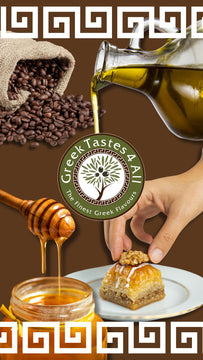Extra Virgin Olive Oil : 3 simple steps how to taste, evaluate and buy Olive Oil !!
Extra Virgin Olive Oil : 3 simple steps how to taste, evaluate and buy Olive Oil !!
Many of us have been found themselves in the unpleasant situation of buying olive oil and paying it for fresh extra virgin olive oil ... but to finally find out that we got gas oil…….
In order to avoid situations like that, It is important for all of the retail customers and not experts, to follow some simple steps that will help them to evaluate the quality of the oil they buy.
Basic principle: "We understand the quality of the oil with our nose and tongue. And with our throat (esophagus). " This is what old farmers used to say, according to their unmistakable experience, and we should not underestimate it. So, the good/intense smell and taste of the oil is what we look for when we want to ‘’name’’ it of high quality and not if it feels spicy on our throat.

Step 1- Odor / Smell
With respect and love to this blessed fruit, we approach our nose, almost touching the spout of the oil container and literally, we try with half-closed or closed eyes, to "absorb" with two-three successive inhalations, all the smell. Let your imagination run and form pictures. If the olive oil is fresh, it will flood you with vivid aromas of olives, trees and nature, as if it came out of the olive mill, at that very moment. To those of us who have an enhanced sense of smell, the aromas will remind you of fruit.
Note: If the aroma is pleasant, your nose will not stop absorbing it.
On the contrary, if the aroma is that are unpleasant, like mould, rotten cheese, refined or burnt oil or dirt, then start to be skeptical about the "oil" you are going to buy because it is neither extra virgin nor fresh. To help you out with that, remember how it smells the oil of the candle when it's finished or how it smells the oil you've forgotten for more than a year in a tin or bottle. This is how a spoiled olive oil smells.
Note: Practically, if the odors are unpleasant, your nose will "be blocked", you will start to have difficulty in the second inhalation and it will "ask" you to move away from the oil.

Step 2- Taste
Put some olive oil in a small glass. The method to test the oil with the finger is not the appropriate to draw safe conclusions. Make sure that the oil is not too cold during the test. For this reason "hug" the glass with your palms for 1-2 minutes to increase its temperature and help the oil to release more of its substances.
Then take a slip of the oil and get the impression of the entire mouth and tongue. Start to feel the flavors first on your tongue and then on your palate, for about 2 seconds or more before you swallow it.
Your taste must be dominated by the feeling of this viscous liquid, with constant alternation of its bittersweet taste. When the oil is an ‘’agourelaio’’, ie from early green olives, the bitter-spicy-pepper flavor prevails and this is a characteristic of the "Koreneiki" variety. On the contrary, the sweet taste dominates when the fruit is ripe and black and is usually a characteristic of the ‘’Manaki’’ variety.
1st note: The bitter-spicy-peppery flavor of the ‘’agourelaio’’ is a feature of extra virgin olive oil and in no way is considered a drawback. Instead, you should know that the ‘’agourelaio’’ (olive oil from early green olives) is not only more durable but it also contains more valuable ingredients as well as more antioxidants, which are known to be anti-cancer.
2nd note: As you swallow the oil you may feel a slight "burning" on your throat. This has nothing to do with the tangle we will mention below. It should not faze you at all and you shouldn’t even take it into consideration because all fresh olive oil (more or less) will leave you with that sense for a while.
On the contrary, if you feel an unpleasant rancid or musty in your taste. Basically a moldy flavour that appears when the olives are stored for several days in a humid environment and develop yeast and fungi.
If you feel a strong and unbearable bitter taste in your mouth, like when you swallow a bitter medicine or eating a grapefruit without sugar or If you get a feeling lubricants or chemicals on your tongue, palate or lips, then it has nothing to do with extra virgin olive oil and it is good to avoid it.

Step 3- Color
Although colour is not a basic factor for the quality of olive oil, however, it can be an indicator that olive oil is a fresh crop.
The colour, whether is greenish or golden yellow, in fresh olive oil is very intense, vivid and lively with a slight refraction when illuminating, like a gentle blur (not total blur).
On the contrary, if the olive oil has been exposed to high temperatures, especially in the summer period, has been exposed to air or light, or it is old (not like the old wine), then it goes bad, ie its colour and density are weakening. The oil becomes so transparent that you can see through the bottle, as it is colored water.









